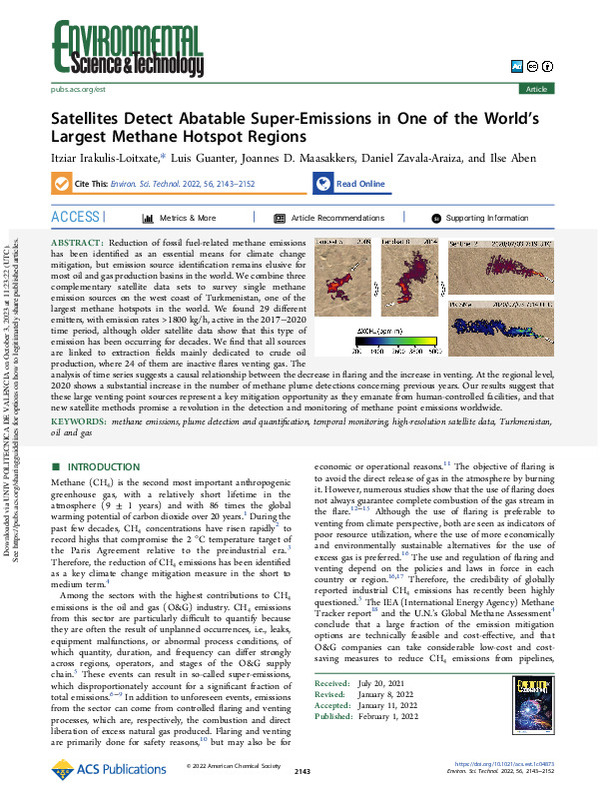JavaScript is disabled for your browser. Some features of this site may not work without it.
Buscar en RiuNet
Listar
Mi cuenta
Estadísticas
Ayuda RiuNet
Admin. UPV
Satellites Detect Abatable Super-Emissions in One of the World¿s Largest Methane Hotspot Regions
Mostrar el registro sencillo del ítem
Ficheros en el ítem
| dc.contributor.author | Irakulis-Loitxate, Itziar
|
es_ES |
| dc.contributor.author | Guanter-Palomar, Luis María
|
es_ES |
| dc.contributor.author | Joannes D. Maasakkers
|
es_ES |
| dc.contributor.author | Daniel Zavala-Araiza
|
es_ES |
| dc.contributor.author | Ilse Aben
|
es_ES |
| dc.date.accessioned | 2023-10-31T19:01:14Z | |
| dc.date.available | 2023-10-31T19:01:14Z | |
| dc.date.issued | 2022-02-15 | es_ES |
| dc.identifier.uri | http://hdl.handle.net/10251/199068 | |
| dc.description.abstract | [EN] Reduction of fossil fuel-related methane emissions has been identified as an essential means for climate change mitigation, but emission source identification remains elusive for most oil and gas production basins in the world. We combine three complementary satellite data sets to survey single methane emission sources on the west coast of Turkmenistan, one of the largest methane hotspots in the world. We found 29 different emitters, with emission rates >1800 kg/h, active in the 2017¿2020 time period, although older satellite data show that this type of emission has been occurring for decades. We find that all sources are linked to extraction fields mainly dedicated to crude oil production, where 24 of them are inactive flares venting gas. The analysis of time series suggests a causal relationship between the decrease in flaring and the increase in venting. At the regional level, 2020 shows a substantial increase in the number of methane plume detections concerning previous years. Our results suggest that these large venting point sources represent a key mitigation opportunity as they emanate from human-controlled facilities, and that new satellite methods promise a revolution in the detection and monitoring of methane point emissions worldwide. | es_ES |
| dc.description.sponsorship | The authors thank the team that realized the TROPOMI instrument and its data products, consisting of the partnership between Airbus Defense and Space Netherlands, KNMI, SRON, and TNO, commissioned by NSO and ESA. Sentinel-5 Precursor is part of the EU Copernicus program, Copernicus (modified) Sentinel-5P data (2018-2020) have been used. We thank the Sentinel Hub service for providing the EO Browser service. Thanks to the Environmental Defense Fund (EDF) for providing data about the O&G fields of the study area, and the Carbon Limits group for contributing to the verification of the emission sources. We thank the Italian Space Agency for the PRISMA data used in this work. Dr. Yongguang Zhang from the University of Nanjing is also thanked for his support to get access to ZY1 AHSI data, and Dr. Javier Gorrono from Universitat Politecnica de Valencia for his assistance in the uncertainty estimations. Authors Itziar Irakulis-Loitxate and Luis Guanter received funding from ESA Contract 4000134929. | es_ES |
| dc.language | Inglés | es_ES |
| dc.publisher | American Chemical Society | es_ES |
| dc.relation.ispartof | Environmental Science & Technology (Online) | es_ES |
| dc.rights | Reconocimiento (by) | es_ES |
| dc.subject | Methane emissions | es_ES |
| dc.subject | Plume detection and quantification | es_ES |
| dc.subject | Temporal monitoring | es_ES |
| dc.subject | High-resolution satellite data | es_ES |
| dc.subject | Turkmenistan | es_ES |
| dc.subject | Oil and gas | es_ES |
| dc.subject.classification | FISICA APLICADA | es_ES |
| dc.title | Satellites Detect Abatable Super-Emissions in One of the World¿s Largest Methane Hotspot Regions | es_ES |
| dc.type | Artículo | es_ES |
| dc.identifier.doi | 10.1021/acs.est.1c04873 | es_ES |
| dc.relation.projectID | info:eu-repo/grantAgreement/ESA// 4000134929/ | es_ES |
| dc.rights.accessRights | Abierto | es_ES |
| dc.contributor.affiliation | Universitat Politècnica de València. Escuela Técnica Superior de Ingenieros de Telecomunicación - Escola Tècnica Superior d'Enginyers de Telecomunicació | es_ES |
| dc.description.bibliographicCitation | Irakulis-Loitxate, I.; Guanter-Palomar, LM.; Joannes D. Maasakkers; Daniel Zavala-Araiza; Ilse Aben (2022). Satellites Detect Abatable Super-Emissions in One of the World¿s Largest Methane Hotspot Regions. Environmental Science & Technology (Online). 56(4):2143-2152. https://doi.org/10.1021/acs.est.1c04873 | es_ES |
| dc.description.accrualMethod | S | es_ES |
| dc.relation.publisherversion | https://doi.org/10.1021/acs.est.1c04873 | es_ES |
| dc.description.upvformatpinicio | 2143 | es_ES |
| dc.description.upvformatpfin | 2152 | es_ES |
| dc.type.version | info:eu-repo/semantics/publishedVersion | es_ES |
| dc.description.volume | 56 | es_ES |
| dc.description.issue | 4 | es_ES |
| dc.identifier.eissn | 1520-5851 | es_ES |
| dc.identifier.pmid | 35102741 | es_ES |
| dc.identifier.pmcid | PMC9940854 | es_ES |
| dc.relation.pasarela | S\455394 | es_ES |
| dc.contributor.funder | European Space Agency | es_ES |
| dc.contributor.funder | Universitat Politècnica de València | es_ES |
| dc.subject.ods | 13.- Tomar medidas urgentes para combatir el cambio climático y sus efectos | es_ES |








